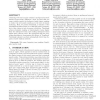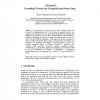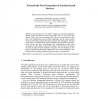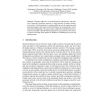WEBDB
2007
Springer
14 years 5 months ago
2007
Springer
XML information retrieval (XML-IR) systems utilize the logical structure of XML documents for retrieving relevant elements. From a practical point of view, displaying the search r...
WEBDB
2007
Springer
14 years 5 months ago
2007
Springer
Clustering web search engine results for ambiguous keyword searches poses unique challenges. First, we show that one cannot readily import the frequency based feature ranking to c...
WEBDB
2007
Springer
14 years 5 months ago
2007
Springer
Open Information Extraction (OIE) is a recently-introduced type of information extraction that extracts small individual pieces of data from input text without any domainspecific...
WEBDB
2007
Springer
14 years 5 months ago
2007
Springer
With the massive adoption of internet technologies, social media and blogs have become primary means of expressing opinions online. The Blogosphere contains a wealth of informatio...
WEBDB
2007
Springer
14 years 5 months ago
2007
Springer
A large volume of geospatial data is available on the web through various forms of applications. However, access to these data is limited by certain types of queries due to restric...
WEBDB
2007
Springer
14 years 5 months ago
2007
Springer
The Internet has changed the way people look for information. Users now expect the answers to their questions to be available through a simple web search. Web search engines are i...
W2GIS
2007
Springer
14 years 5 months ago
2007
Springer
W2GIS
2007
Springer
14 years 5 months ago
2007
Springer
User interaction is mostly based on forms. However, forms are restricted to alphanumerical data – the editing of geospatial data is not supported. This statement does not only ho...
W2GIS
2007
Springer
14 years 5 months ago
2007
Springer
Location-based services (LBS) constitute an emerging application domain rapidly introduced in modern life habits. However, given that LBS already count a few years of commercial li...
W2GIS
2007
Springer
14 years 5 months ago
2007
Springer
Abstract. This paper addresses—to our knowledge, for the first time—the problem of querying a geosensor network—a sensor network of mobile, locationaware nodes—for histori...




